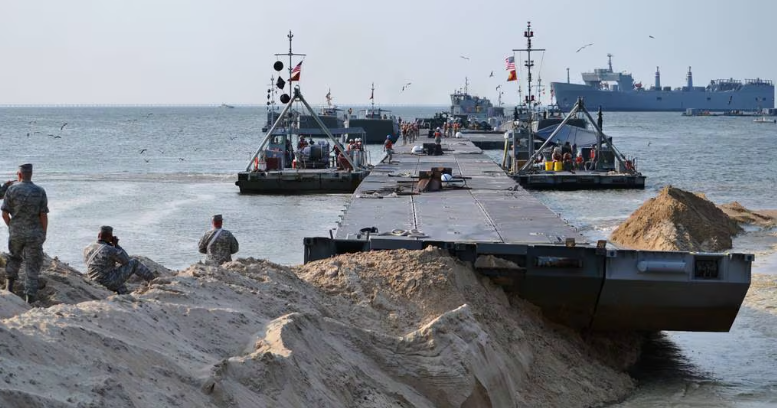
UPDATE:
Please watch below a superb video discussion of the proposed Joint Logistics Over the Shore (JLOTS) capability by Sal Mercogliano, maritime historian at Campbell University and former merchant mariner: JLOTS background, configurations, capabilities, challenges and security issues
Original Post:
On March 5, Ramesh Rajasingham, director of the U.N. Office for the Coordination of Humanitarian Affairs, said in a briefing that “576,000 people in Gaza – one-quarter of the population – [are] one step away from famine; with 1 in 6 children under 2 years of age in northern Gaza suffering from acute malnutrition and wasting; and practically the entire population of Gaza left to rely on woefully inadequate humanitarian food assistance to survive…” Something Netanyahu has denied.
Nearly two weeks ago, U.S. and Jordanian aircraft began airdropping desperately needed food to Palestinians in Gaza.
The airdrops have continued. However, the amount of relief supplies delivered by air, although much welcomed by the people in Gaza, is by no means sufficient to mitigate the humanitarian crisis.
After the first airdrop, one U.S. Defense official said “We’re looking at the land routes, we’re looking at a sea route, we’re looking at the air route to really ensure that we’re exploring every opportunity to get assistance in.”
And indeed, other avenues are being pursued.
During the recent State of the Union address, President Biden announced a U.S.-led, DoD-undertaken, emergency mission to establish a temporary floating pier off the coast of Gaza to deliver up to 2,000,000 meals per-day for Gaza’s 2.3 million people.
This project has the potential to increase the amount of aid currently flowing into Gaza by several orders of magnitude.
The construction of the Joint Logistics Over-the-Shore capability, or JLOTS, will be under the command of the U.S. Transportation Command and conducted by the 7thTransportation Brigade from Joint Base Langley-Eustis, Virginia and other units.
According to DoD, JLOTS will include a floating pier, an approximately 1,800-foot-long modular causeway, assembled offshore and then attached to the shore, and a group of logistic support vessels and barges that will transport the aid from the pier to the causeway where the cargo would be offloaded and transported to the land and distributed to Gaza.
Cyprus has been mentioned as one possible location from where the aid could be loaded onto (commercial) ships for transport to the Gaza pier.
DoD estimates that JLOTS could be operational in 60 days, including “the time it will take to transport some of the JLOTS components from Virginia to the Middle East.” More than 1,000 American troops would be involved in the effort.
Both President Biden and DoD have maintained that no American troops will set foot into the Gaza Strip, “instead passing the aid to trusted partners on the ground.”
Many have expressed concerns about U.S. boots on the ground in Gaza and our troops being exposed to harm.
The ability to do this without putting forces on ground is due to the fact that the causeway is essentially modular, built at sea, and then driven into the ground from offshore…We’ll be working with partners in the region to be on the receiving end of , but at no time will we require U.S. forces to actually go on the ground. Our role will be essentially to provide the service of getting to the causeway, at which point it will then be distributed.
There are still many questions and concerns over how troops, the pier and the causeway will be protected from attacks by Hamas.
Air Force Maj. Gen. Pat Ryder, a Pentagon spokesman, says Israel is part of the planning process and could provide security through its own forces. “If Hamas truly does care about the Palestinian people, then again, one would hope that this international mission to deliver aid to people who need it would be able to happen and unhindered,” he adds.
The Institute for the Study of War (ISW) reports that a US Army logistics support vessel has departed from Virginia to the Eastern Mediterranean Sea with the first load of equipment to establish JLOTS.
















